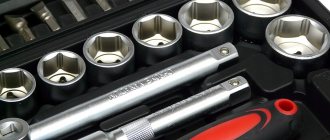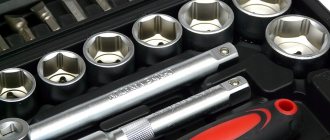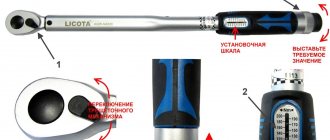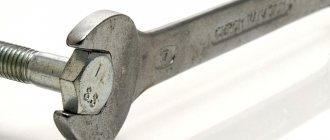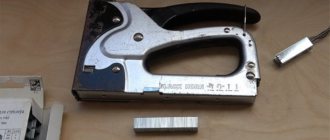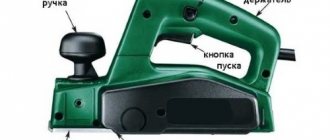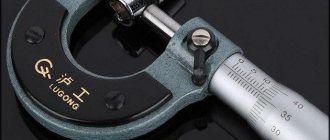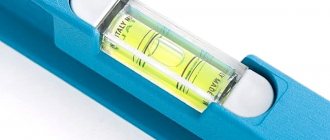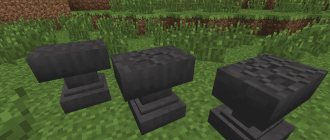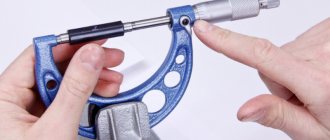An indispensable tool in the arsenal of every home craftsman is a wrench. The domestic industry produces them for every taste and budget: from the lightest and smallest (for working with electronics and household appliances) to large and heavy (these are often used when repairing machines and other equipment, as well as during the maintenance of ground transport). As a rule, they are made from high-quality solid metal or an alloy of several metals.
Recently, new models equipped with additional devices that greatly facilitate the work of the home craftsman have become very popular. Tools for tightening nuts, equipped with a so-called ratchet, are in great demand in specialized stores. However, it would be more correct to use the following name: “wrench with built-in ratchet .
There is a solution for every problem
Let's look at an example - inspecting the condition of fasteners. This is necessary if you want the equipment to work smoothly for a long time. What happens if you neglect this responsibility? Loose fasteners lead to a deterioration in the accuracy and speed of operations and, as a consequence, to the production of products of poorer quality. And soon the equipment itself will fail. Let's take a lathe as an example. One of the points in the maintenance rules is to regularly check and tighten the lead screws and ensure clearance between them and the slide. Failure to comply with the prescribed requirements will lead to gradual loosening of the screws. The required gap will disappear completely over time - the slide will rest on the screws. Further consequences of this process are described above. Don't wait - it's better to prevent them with a ratchet wrench.
Another example: a buyer purchased a ratchet wrench to work in a narrow niche, for example, when repairing a car, where it would be impossible to swing a regular wrench. And I encountered a problem: in order to grab the next edge of the nut, the wrench had to be pulled back very far, and there was practically no room for this. Why did this happen? Because the gear that was in the key did not have enough teeth. The solution in this situation is to use a high-quality ratchet wrench with 72 teeth. This is an important decision you need to make: are you willing to invest money twice in purchasing a wrench or are you ready to immediately purchase a quality tool. If you have made the right decision, then we will figure out what kind of ratchet wrenches there are and for what work they are needed.
Removing the ratchet from the bike
It is not always possible to correctly see the malfunction when the ratchet mechanism is on the bicycle itself, so the best solution would be to disassemble it.
It will not be possible to simply remove the ratchet mechanism, so we will need a special tool - a puller. With the help of this simple device, the ratchet will quickly be removed from its rightful place.
Tool for removing and securing the ratchet
Second model
This version of the tool is more popular than the previous model.
There are already 24 teeth, and there is a reverse flag, by switching which we get the reverse stroke of the tool.
This model also has a head locking function that does not allow you to remove/put on the head.
Ratchet wrench
Hi all. In today's review we will talk about ring spanners with ratchet. Not long ago I told you what came of my attempt to acquire a set of such keys. There I also wrote that in addition to the ordered set, several keys were purchased that were not in the set. These are the ones we will talk about. So, 2 keys were additionally ordered: 9 and 11 millimeters. They were ordered from a different store where the set was purchased. This seller was much more careful and sent me exactly what I ordered. At the time of purchase, the 9 mm wrench cost me $2.87, and the 11 mm wrench cost $3.58. Unfortunately, the parcel did not have a track, so it will not be possible to find out which route the parcel took to Belarus. But here you can see the movement of the parcel within China.
About a month after placing the order, the parcel was successfully received. The keys are supplied without any original packaging. Perhaps, if you buy a set, it will be in some kind of box, but keys purchased separately will only have plastic bags from the packaging.
Apart from the designation of the key size, there are no inscriptions on the received samples at all. So it is not possible to find out the manufacturer. But, despite the fact that the keys are nameless, they look very nice in appearance. Taking the key in your hand, you feel its weight. You definitely can’t call them easy. A 9 key weighs 1.5 times heavier than a regular 10 key. I also have no complaints about the quality of the keys, everything is carefully processed, no burrs or scratches. The ratchet rotates with a slight, even force, the clicks of the mechanism are audible perfectly. All the keys were covered with some kind of foul-smelling grease, so I had to clean them thoroughly before picking them up.
Ratchet wrench
A tool equipped with a ratchet consists of the following elements:
- The main part, or body. This is a flat metal plate that can have different lengths, widths and thicknesses, depending on its purpose.
- The end designed for tightening and unscrewing nuts. Despite the fact that it is traditionally called a “nut,” it can be used to tighten not only nuts, but also bolts, as well as other types of fasteners. The working end of the tool visually resembles a fork with two slightly curved teeth. Their curvature may be different. There is free space between the teeth, which are parallel to each other. The distance from one tooth to another can vary. When the teeth tightly grip the nut or bolt, the home technician makes rotational movements (clockwise to tighten, counterclockwise to unscrew). Thanks to the applied physical force, the fastener comes out of its socket or, conversely, fits tightly into it.
- The end opposite the working one. There is a hole in the housing at this end. Its diameter may vary depending on the size of the tool. This end is auxiliary; the home master holds the tool by it while working.
- The ratchet itself is a mechanism that facilitates the work of tightening and unscrewing fasteners. It is located in the hole, which is located at the auxiliary end of the tool. The ratchet got its name because it makes characteristic sounds during operation.
Main advantages and disadvantages
Here are the main advantages of a ratchet wrench:
- When screwing or unscrewing fasteners, the master may not turn it completely around its axis. All you have to do is turn it slightly and the ratchet will do the rest of the work. This advantage is of particular importance in cases where the tool is heavy, large and therefore inconvenient to work with.
- The ratchet increases the speed of work and helps to tighten the nuts very tightly without much effort.
- Such a device costs only a little more than a classic wrench. However, thanks to it, the efficiency and speed of work increase several times.
- The tool is very convenient in cases where you need to quickly tighten or unscrew a large number of fasteners.
However, the device also has disadvantages. In particular, due to the presence of a ratchet at the auxiliary end of the tool, holding it is sometimes not very convenient . If the home technician holds the key incorrectly, he may injure the soft tissues of the palm. In addition, the presence of a ratchet increases weight and length. And finally, ratchets on foreign-made wrenches do not always fit domestic bolts and nuts. Therefore, when purchasing products from well-known Western companies, the home master risks paying money in vain.
Key purpose
Wrenches come in a variety of sizes and shapes. Many home craftsmen often use them during renovation work in an apartment or house. For example, a large tool is very convenient when you need to open an old valve, rusted from time to time, to bleed air from a steam heating radiator. Plumbers often use this tool when repairing sinks and toilet cisterns. Also, tools equipped with an additional mechanism are used:
- At car and public transport service stations;
- In railway depots during the repair of rolling stock;
- During construction work;
- When repairing household appliances and electronics;
- For installation and dismantling of furniture: beds, sideboards and walls, bookcases and wardrobes.
The largest and heaviest wrenches are used to repair cars, while the smallest and thinnest are used to repair a variety of household appliances and electronics. In order to select the appropriate size wrench, you need to know the size of the fasteners. Experienced repair specialists determine it by eye and immediately select the right one.
Purchasing plumbing supplies
To achieve maximum efficiency, you need the right equipment. The main requirement for slip-on devices is that the dimensions of the fastening surface ideally match. It is also recommended to have a set of mechanisms of various calibers on hand. This will make it easier to select the right tool. As a rule, it should contain five or six of the most popular copies. There are universal sets of wrenches. In addition to simple ones, they may include long and short tools, as well as various special keys and keys with increased strength.
You can select special removable heads and open-end wrenches in the kit. With a ratchet, a set of such locksmith tools will not leave you with impossible tasks.
Types of ratchets
Before choosing a ratchet, you need to determine what types of this hand tool there are. In most cases, craftsmen divide all models into 6 categories depending on the type of structure. Representatives of each of them have unique advantages and disadvantages, and are also suitable for performing a certain type of task.
Classification by type of construction:
- Reversible. This type of ratchet gets its name due to its reverse function. It allows you to screw and unscrew fasteners without moving the tool from one face to another. The reverse is turned on and off using a special core located in the central part of the key.
- With swivel head. Products of this type are the most versatile. They are equipped with a special head that rotates in different directions and allows you to unscrew fasteners located at any angle to the master. This structural element is often supplemented with a spring ball that holds the working head of the tool.
- Telescopic. Ratchets belonging to this type are equipped with a telescopic handle. Its presence allows the user to independently choose the optimal length of the tool and reach any structural elements.
- Shortened. Products of this type are ideal for working in confined spaces. They are equipped with the shortest possible handle, thanks to which the master can get to fasteners located in narrow places.
- Reinforced. These tools stand out for their durable construction. Thanks to it, craftsmen can make maximum efforts to unscrew damaged nuts (for example, those covered with rust), without fear of the key breaking.
- Articulated. Models of this type are similar in appearance to keys with a rotary mechanism. Their difference lies in the presence of a movable hinge located between the handle and the working head of the tool. It allows you to tilt the working part at any angle and reach hard-to-reach fasteners.
Types of ratchet wrenches:
In addition to standard mechanical ratchet wrenches, there are special wrenches that operate on the same principle, but in a different way.
This is a wrench that can tighten fasteners with a given amount of force. It is often used in car repair shops where it is necessary to securely fasten the fasteners without stripping the threads.
This type of wrench is powered by compressed air, has a bi-directional switch, and is equipped with a trigger mechanism that releases high-pressure air and rotates the head.
Jonnesway tools have earned a reputation for quality, ease of use and long service life. Most power tools come with a lifetime warranty. With the Jonnesway tool you can complete any job quickly and easily. Thanks to the special coating, it is easy to remove dirt from it, and its appearance will delight you throughout its entire service life.
Auto repair school - Do-it-yourself car repair
Nov 4, 2016 Garage by admin
I think that every car enthusiast, car mechanic, electrician, plumber has his own favorite tool, which is made specifically for his hand and has been serving reliably for many years. When such a tool (wrench, screwdriver, pliers, hammer, etc.) breaks down and becomes unusable, the mood from such an event worsens sharply. Here you have the loss of a faithful comrade-in-arms, and additional financial expenses... Sound familiar? So, for example, it happened with me. One fine day, my favorite ratchet wrench from TOPTUL broke. At first, however, I thought it was nothing serious. Since the key is not in use for the first day and a similar problem has already happened to it a couple of times (while tightening it started to slip, running idle). And this problem was solved by disassembling, cleaning and washing the internal contents of the key, reassembling and then lubricating the mechanism. That's all. After such a simple procedure, the key began to work like new.
But this time washing and cleaning did not give any results. The ratchet continued to slip. A careful examination of the mechanism parts revealed signs of wear on the toothed roller and, especially, the locking pawls. In photo number 1 it may not be clear, but the worn teeth of the pawls are still visible.
I was upset, of course. I decided - the key worked. You'll have to write off your pet and buy a replacement. I went to the market. And, to my surprise, the seller, after listening to the sad story of how I lost my faithful assistant, offered me not a new key, but a kit for repairing the old ratchet key. Oh how! In photos 2 and 3 you can see a branded package with a repair kit and a set of parts that are included in it. This repair kit fits TOPTUL ratchet wrenches with numbers CHAG0813 and CJBG0815 (the head square on these wrenches is 1/4).
After purchasing the repair kit, all that remains is to install it. There is nothing difficult in this activity. But, I still decided to make a small photo report on the repair of the ratchet wrench . I hope you find it interesting. And if something similar happens to your ratchet, you can easily and quickly repair the key with your own hands .
For work you will need: screwdrivers or heads for Torx slots T7 and T8 (photo 4). And tweezers (it will be difficult to handle small springs with just your fingers, I personally checked this
